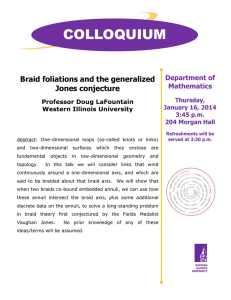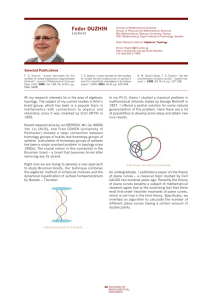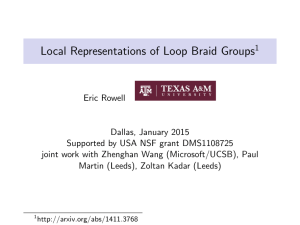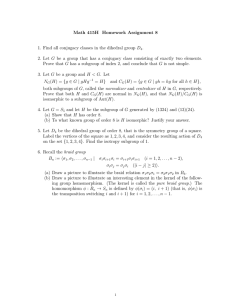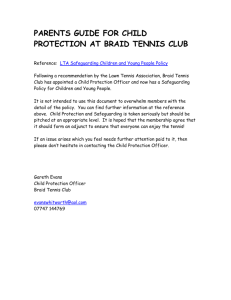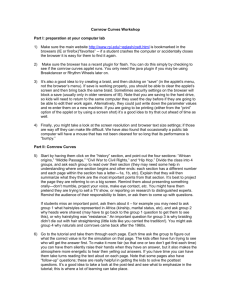New developments in the theory of Artin’s braid groups 1 Introduction.
advertisement
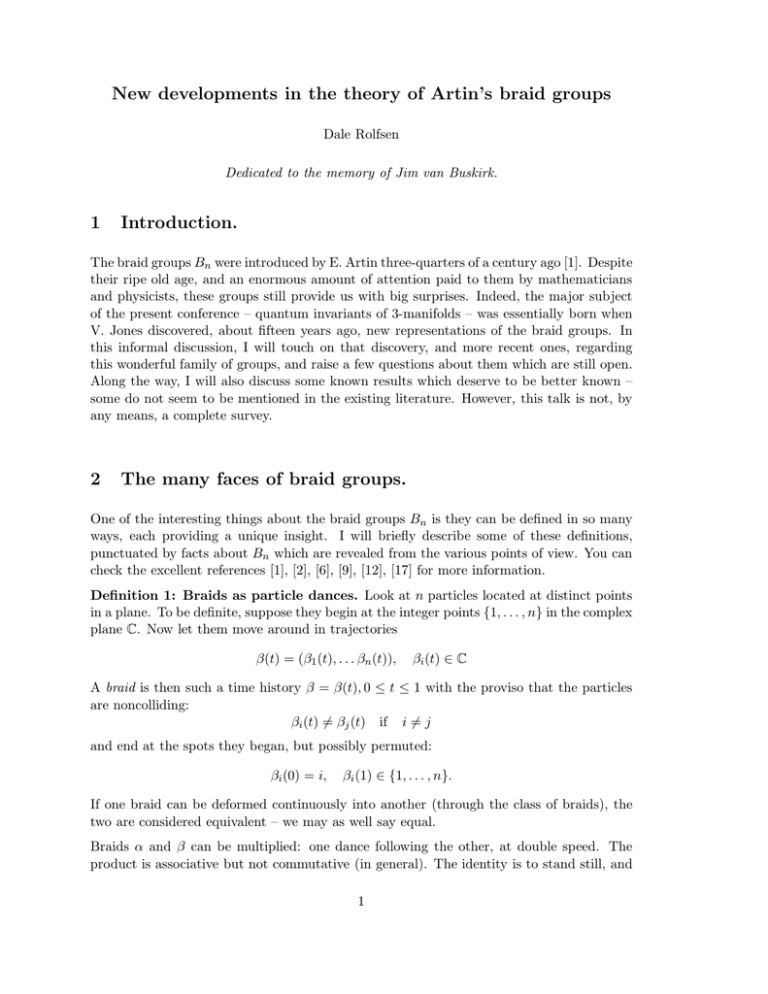
New developments in the theory of Artin’s braid groups
Dale Rolfsen
Dedicated to the memory of Jim van Buskirk.
1
Introduction.
The braid groups Bn were introduced by E. Artin three-quarters of a century ago [1]. Despite
their ripe old age, and an enormous amount of attention paid to them by mathematicians
and physicists, these groups still provide us with big surprises. Indeed, the major subject
of the present conference – quantum invariants of 3-manifolds – was essentially born when
V. Jones discovered, about fifteen years ago, new representations of the braid groups. In
this informal discussion, I will touch on that discovery, and more recent ones, regarding
this wonderful family of groups, and raise a few questions about them which are still open.
Along the way, I will also discuss some known results which deserve to be better known –
some do not seem to be mentioned in the existing literature. However, this talk is not, by
any means, a complete survey.
2
The many faces of braid groups.
One of the interesting things about the braid groups Bn is they can be defined in so many
ways, each providing a unique insight. I will briefly describe some of these definitions,
punctuated by facts about Bn which are revealed from the various points of view. You can
check the excellent references [1], [2], [6], [9], [12], [17] for more information.
Definition 1: Braids as particle dances. Look at n particles located at distinct points
in a plane. To be definite, suppose they begin at the integer points {1, . . . , n} in the complex
plane C. Now let them move around in trajectories
β(t) = (β1 (t), . . . βn (t)),
βi (t) ∈ C
A braid is then such a time history β = β(t), 0 ≤ t ≤ 1 with the proviso that the particles
are noncolliding:
βi (t) 6= βj (t) if i =
6 j
and end at the spots they began, but possibly permuted:
βi (0) = i,
βi (1) ∈ {1, . . . , n}.
If one braid can be deformed continuously into another (through the class of braids), the
two are considered equivalent – we may as well say equal.
Braids α and β can be multiplied: one dance following the other, at double speed. The
product is associative but not commutative (in general). The identity is to stand still, and
1
each dance has an inverse; doing the dance in reverse. These (deformation classes of) dances
form the group Bn .
A braid β defines a permutation i → βi (1) which is a well-defined element of the permutation
group Σn . This is a homomorphism with kernel, by definition, the subgroup Pn < Bn of
pure braids. Pn is sometimes called the colored braid group, as the particles can be regarded
as having identities, or colors. Pn is of course normal in Bn , of index n!, and there is an
exact sequence
1 → Pn → Bn → Σn → 1.
Definition 2: Braids as strings in 3-D. This is the usual and visually appealing picture.
A braid can be viewed as its graph, or timeline, in real x, √
y, t-space, monotone in the t
direction. The complex part is described as usual by x + y −1. The product is then a
concatenation of braided strings.
This viewpoint provides the connection with knots. A braid β defines a knot or link β̂, its
closure, by connecting the endpoints in a standard way.
Figure 1: The closure of a braid.
Definition 3: Bn as a fundamental group. In complex n-space Cn consider the big
diagonal
∆ = {(z1 , . . . , zn ); zi = zj , some i < j} ⊂ Cn .
Using the basepoint (1, 2, . . . , n), we see that
Pn = π1 (Cn \ ∆).
In other words, pure braid groups are fundamental groups of complements of a special sort
of complex hyperplane arrangement, itself a deep and complicated subject.
To get the full braid group we need to take the fundamental group of the configuration
space, of orbits of the obvious action of Σn upon Cn \ ∆. Thus
Bn = π1 ((Cn \ ∆)/Σn ).
Notice that since the singularities have been removed, the projection
Cn \ ∆ −→ (Cn \ ∆)/Σn
2
is actually a covering map. As is well-known, covering maps induce injective homomorphisms at the π1 level, so this is another way to think of the inclusion Pn ⊂ Bn .
It was observed in [14] that Cn \ ∆ has trivial homotopy groups in dimension greater
than one. That is, it is an Eilenberg-Maclane space, also known as a K(Pn , 1). Therefore
its cohomology groups coincide with the group cohomology of Pn . By covering theory, the
quotient space (Cn \ ∆)/Σn also has trivial higher homotopy, so it is a K(Bn , 1). Since these
spaces have real dimension 2n, this view of braid groups gives us the following observation.
Theorem 2.1 The groups Bn and Pn have finite cohomological dimension.
If a group contains an element of finite order, standard homological algebra implies that the
cohomological dimension of the group must be infinite. Thus there are no braids of finite
order.
Corollary 2.2 The braid groups are torsion-free.
Finally, we note that the space (Cn \ ∆)/Σn can be identified with the space of all complex
polynomials of degree n which are monic and have n distinct roots
p(z) = (z − r1 ) · · · (z − rn ).
This is one way in which the braid groups play a role in classical algebraic geometry, as
fundamental groups of such spaces of polynomials.
Definition 4: The algebraic braid group. Bn can be regarded algebraically as the
group presented with generators σ1 , . . . , σn−1 , where σi is the braid with one crossing, with
the string at level i (counting from the bottom) crossing over the one at level i + 1 and the
other strings going straight across. In Figure 1, for example, the braid could be written
either as σ2−1 σ1−1 σ3 σ2 σ1−1 or σ2−1 σ3 σ1−1 σ2 σ1−1 (or indeed many other ways).
These generators are subject to the relations
σi σj = σj σi , |i − j| > 1,
σi σj σi = σj σi σj , |i − j| = 1.
We can take a whole countable set of generators σ1 , σ2 , . . . subject to the above relations,
which defines the infinite braid group B∞ . If we consider the (non-normal) subgroup generated by σ1 , . . . , σn−1 , these algebraically define Bn . Notice that this convention gives
“natural” inclusions Bn ⊂ Bn+1 and Pn ⊂ Pn+1 .
Going the other way, if one forgets the last string of an n + 1-braid the result is an n-braid.
But strictly speaking, this is only a well defined homomorphism for pure braids, (or at best
for the subgroup of braids in which the string beginning at the point n + 1 also ends there).
Later, we will have a use for this forgetful map
f : Pn+1 → Pn
3
It is easy to see that f is a left inverse of the inclusion, or in other words a retraction in the
category of groups.
Artin Combing. We now have the ingredients for the combing technique, by which Artin
solved the word problem for pure braid groups, and therefore for the full braid groups.
Let β be a pure n-braid and f (β) the pure n − 1 braid obtained by forgetting the last string,
but then by inclusion, regard f (β) in Pn . Then β and f (β) can be visualized as the same
braid, except the last string has been changed so as to have no interaction with the other
strings. Let K be the kernel of f . Then it is easy to verify that f (β)−1 β ∈ K and the map
β → (f (β), f (β)−1 β)
maps Pn bijectively onto the cartesian product Pn−1 × K. However, the multiplicative
structure is that of a semidirect product, as happens whenever we have a group retraction.
Also notice that every element of K can be represented by a braid in which the first n − 1
strands go straight across. In this way we identify K with the fundamental group of the
complement of the points {1, . . . , n − 1} in the plane, which is a free group: K ∼
= Fn−1 . This
process can then be iterated on Pn−1 to obtain the Artin normal form: Pn is an iterated
semidirect product of free groups F1 , F2 , . . . , Fn−1 .
Theorem 2.3 There is an algorithmic solution to the word problem in Pn and Bn .
Now to solve the word problem in Pn – to decide whether a braid β expressed as a word in
the generators is trivial in the group – construct the unique expansion
β = β1 β2 · · · βn−1
from the Artin combing, with βj ∈ Fj . The word problem in free groups being very easy
(two words represent the same group element iff their reduced forms are equal) we have
solved the word problem for Pn . Since Pn has finite index in Bn , it is straightforward to
extend this to a solution of the word problem in the full braid group Bn . For later reference,
we will call the vector
(β1 , β2 , · · · , βn−1 )
the “Artin coordinates” of β.
Definition 5: Bn as a mapping class group. Going back to the first definition, imagine
the particles are in a sort of planar jello and pull their surroundings with them as they dance
about. Topologically speaking, the motion of the particles extends to a continuous family
of homeomorphisms of the plane (or of a disk, fixed on the boundary). This describes an
equivalence between Bn and the mapping class of Dn , the disk D with n punctures (marked
points). That is, Bn can be considered as the group of homeomorphisms of Dn fixing ∂D
and permuting the punctures, modulo isotopy fixing ∂D ∪ {1, . . . , n}.
Definition 6: Bn as a group of automorphisms. A mapping class [h], where h : Dn →
Dn gives rise to an automorphism h∗ : Fn → Fn of free groups. Using the interpretation of
braids as mapping classes, this defines a homomorphism
4
Bn → Aut(Fn ),
which Artin showed to be faithful, i. e. injective.
The generator σi acts as
xi → xi xi+1 x−1
i
xi+1 → xi
xj → xj , j 6= i, i + 1.
(1)
Theorem 2.4 (Artin) Under the identification described above, Bn is the set of automorphisms h ∈ Aut(Fn ) of the form
h(xi ) = wj−1 xj wj ,
where wj are words in Fn , and satisfying h(x1 · · · xn ) = x1 · · · xn .
This point of view gives further insight into the group-theoretic properties of braid groups.
Recall that a group G is residually finite if for every g ∈ G there is a homomorphism
h : G → F onto a finite group F such that h(g) is not the identity. It is well-known that
free groups are residually finite. A nice argument due to Baumslag [4] (see [21]) shows that
the group of automorphisms of a finitely generated residually finite group is itself residually
finite. Thus Aut(Fn ) is residually finite, as are all its subgroups.
Theorem 2.5 Bn is residually finite.
It follows immediately (see [21]) that
Theorem 2.6 Bn is Hopfian, that is, not isomorphic with a proper quotient of itself.
We close this section with a theorem of W. Thurston. An infinite group is called automatic
if is well-modelled (in a well-defined technical sense which I won’t elaborate here) by a
finite-state automaton. The standard reference is [11].
Theorem 2.7 (Thurston) Bn is automatic.
This implies, for example, that the word problem can be solved by an algorithm which is
quadratic in the length of the input.
5
3
Representations of Bn
This is a very big subject, which I will just touch upon. By a representation of a group
we will mean a homomorphism of the group into a group of matrices, or more generally
into some other group, or ring or algebra. Often, but not always, we want the target to
be finite-dimensional. We’ve already encountered the Artin representation Bn → Aut(Fn ),
which is faithful. Here the target group is far from being “finite-dimensional.”
One of the classical representations of the braid groups is the Burau representation, which
can be described as follows. Consider the definition of Bn as the mapping class group of
the punctured disk Dn (Definition 5). As already noted, the fundamental group of Dn is
a free group, with generator xi represented by a loop, based at a point on the boundary
of the disk, which goes once around the ith puncture. Consider the subgroup of π1 (Dn )
consisting of all words in the xi whose exponent sum is zero. This is a normal subgroup,
and so defines a regular covering space D̄n → Dn . The group of covering translations is
infinite cyclic. Therefore, the homology H1 (D̄n ) can be considered as a module over the
polynomial ring Z[t, t−1 ], where t represents the generator of the covering translation group.
A braid β can be represented as (an isotopy class of) a homeomorphism β : Dn → Dn fixing
the basepoint. This lifts to a homeomorphism β̄ : D¯n → D¯n , which is unique if we insist
that it fix some particular lift of the basepoint. The induced homomorphism on homology,
β̄∗ : H1 (D¯n ) → H1 (D¯n ) is a linear map of these finite-dimensional modules, and so can be
represented by a matrix with entries in Z[t, t−1 ]. The mapping
β → β̄∗
is the Burau representation of Bn . An explicit matrix form, and its relations with the
Alexander polynomial can be found in [6].
It has been known for many years that this representation is faithful for n ≤ 3, and it is
only within the last decade that it was found to be unfaithful for any n at all. John Moody
showed in 1993 [23] that it is unfaithful for n ≥ 9. This has since been improved by Long
and Paton [20] and very recently by Bigelow to n ≥ 5. The case n = 4 remains open, as far
as I am aware.
Another very important representation is the one defined by Jones [16] which gave rise to
his famous knot polynomial, and the subsequent revolution in knot theory. The version I
will discuss is more thoroughly described in [17]; it is based on the Kauffman bracket, an
elementary combinatorial approach to the Jones polynomial. First we need to describe the
Temperley-Lieb Algebras Tn , in their geometric form. The elements of Tn are something
like braids: we consider strings in a box, visualized as a square in the plane, endpoints being
exactly n specified points on each of the left and right sides. The strings are not required
to be monotone, or even to run across from one side to the other. There also may be closed
components. Really what we are looking at are “tangle” diagrams. Two tangle diagrams
are considered equal if there is a planar isotopy, fixed on the boundary of the square, taking
one to the other.
Now we let A be a fixed complex number (regarded as a parameter), and formally define
Tn to be the complex vector space with basis the set of all tangles, as described above,
6
1
0
1
0
1
0
1
0
1
0
1
0
1
0
1
0
1
0
1
0
1
0
1
0
1
0
1
0
1
0
1
0
1
0
1
0
1
0
1
0
Figure 2: A typical element in T5 and the generator e3 .
but modulo the following relations, which correspond to similar relations used to define
Kauffman’s bracket version of the Jones polynomial.
-1
= A
K
+A
=dK,
2
d = -A -A
-2
Figure 3: Relations in Tn .
The first relation means that we can replace a tangle with a crossing by a linear combination
of two tangles with that crossing removed in two ways. As usual, the pictures mean that
the tangles are identical outside the part pictured. The second relation means that we can
remove any closed curve in the diagram, if it does not have any crossings with the rest
of the tangle, at the cost of multiplying the tangle by the scalar −A2 − A−2 . Using the
relations, we see that any element of Tn can be expressed as a linear combination of tangles
which have no crossings and no closed curves – that is, disjoint planar arcs connecting the
2n points of the boundary. This gives a finite generating set, which (for generic values of
A) can be shown to be a basis for Tn as a vector space. But there is also a multiplication
of Tn , a concatenation of tangles, in exactly the same way braids are multiplied. This
enables us to consider Tn to be generated as an algebra by the elements e1 , . . . , en−1 . In ei
all the strings go straight across, except those at level i and i + 1 which are connected by
short caps; the generator e3 of T5 is illustrated in Figure 2. The identity of this algebra is
simply the diagram consisting of n horizontal lines (just like the identity braid). Tn can be
described abstractly as the associative algebra with the generators e1 , . . . , en−1 , subject to
the relations:
ei ei±1 ei = ei
e2i = (−A2 − A−2 )ei
It is an enjoyable exercise to verify these relations from the pictures. Now the Jones representation J : Bn → Tn can be described simply by considering a braid diagram as an
element of the algebra. In terms of generators, this is just
7
J(σi ) = A + A−1 ei
I will have more to say about representations of Bn later.
4
Ordering braid groups
This is one of the most exciting of the recent developments in braid theory. Call a group G
right orderable if its elements can be given a strict total ordering < which is right-invariant:
∀x, y, z ∈ G,
x < y ⇒ xz < yz.
Theorem 4.1 (Dehornoy[10]) Bn is right-orderable.
Interestingly, I know of three quite different proofs. The first is Dehornoy’s, the second
is one that was discovered jointly by myself and four other topologists. We were trying
to understand difficult technical aspects of Dehornoy’s argument, then came up with quite
a different way of looking at exactly the same ordering, but using the view of Bn as the
mapping class group of the punctured disk Dn . Yet a third way is due to Thurston, using
the fact that the universal cover of Dn embeds in the hyperbolic plane. Here are further
details.
Dehornoy’s approach: It is routine to verify that a group G is right-orderable if and only if
there exists a subset Π (positive cone) of G satisfying:
(1) Π · Π = Π
(2) The identity element does not belong to Π, and for every g 6= 1 in G exactly one of
g ∈ Π or g−1 ∈ Π holds.
One defines the ordering by g < h iff hg−1 ∈ Π.
Dehornoy’s idea is to call a braid i-positive if it is expressible as a word in σj , j ≥ i in such
a manner that all the exponents of σi are positive. Then define the set Π ⊂ Bn to be all
braids which are i-positive for some i = 1, . . . , n − 1. To prove (1) above is quite easy, but
(2) requires an extremely tricky argument.
Here is the point of view advocated in [13]. Consider Bn as acting on the complex plane, as
described above. Our idea is to consider the image of the real axis β(R), under a mapping
class β ∈ Bn . Of course there are choices here, but there is a unique “canonical form” in
which (roughly speaking) R ∩ β(R) has the fewest number of components. Now declare a
braid β to be positive if (going from left to right) the first departure of the canonical curve
β(R) from R itself is into the upper half of the complex plane. Amazingly, this simple idea
works, and gives exactly the same ordering as Dehornoy’s combinatorial definition.
Finally, Thurston’s idea for ordering Bn again uses the mapping class point of view, but a
different way at looking at ordering a group. This approach, which has the advantage of
defining infinitely many right-orderings of Bn is described by H. Short and B. Wiest in [27].
8
The Dehornoy ordering (which is discrete) occurs as one of these right-orderings – others
constructed in this way are order-dense. A group G acts on a set X (on the right) if the
mapping x → xg satisfies: x(gh) = (xg)h and x1 = x. An action is effective if the only
element of G which acts as the identity is the identity 1 ∈ G. The following is a useful
criterion for right-orderability:
Lemma 4.2 If the group G acts effectively on R by order-preserving homeomorphisms,
then G is right-orderable.
By way of a proof, consider a well-ordering of the real numbers. Define, for g and h ∈ G,
g < h ⇔ xg < xh at the first x ∈ R such that xg 6= xh.
It is routine to verify that this defines a right-invariant strict total ordering of G. (By the
way, we could have used any ordered set in place of R.) For those wishing to avoid the axiom
of choice (well-ordering R) we could have just used an ordering of the rational numbers.
The universal cover D˜n of Dn can be embedded in the hyperbolic plane H2 in such a way
that the covering translations are isometries. This gives a hyperbolic structure on Dn . It
also gives a beautiful tiling of H2 , illustrated in Figure 4 for the case n = 2.
Choose a basepoint ∗ ∈ ∂D and a specific lift ∗˜ ∈ H2 . Now a braid is represented by
a homeomorphism of Dn , which fixes ∗. This homeomorphism lifts to a homeomorphism
of D˜n , unique if we specify that it fixes ˜∗. In turn, this homeomorphism extends to a
homeomorphism of the boundary of D˜n But in fact, this homeomorphism fixes the interval
of ∂ D˜n containing ˜∗, and if we identify the complement of this interval with the real line
R, a braid defines a homeomorphism of R. This defines an action of Bn upon R by orderpreserving homeomorphisms, and hence a right-invariant ordering of Bn .
Two-sided invariance? Any right-invariant ordering of a group can be converted to a
left-invariant ordering, by comparing inverses of elements, but that ordering is in general
different from the given one. We will say that a group G with strict total ordering < is
fully-ordered, or bi-ordered, if
x < y ⇒ xz < yz and zx < zy, ∀x, y, z ∈ G.
There are groups which are right-orderable but not bi-orderable – in fact the braid groups!
Proposition 4.3 (N. Smythe) For n > 2 the braid group Bn cannot be fully ordered.
The reason for this is that there exists a nontrivial element which is conjugate to its inverse:
take x = σ1 σ2−1 and y = σ1 σ2 σ1 and note that yxy −1 = x−1 . In a bi-ordered group, if 1 < x
then 1 < yxy −1 = x−1 , contradicting the other conclusion x−1 < 1. If x < 1 a similar
contradiction arises.
Theorem 4.4 The pure braid groups Pn can be bi-ordered.
9
Π
Dn∼ ⊂ H2
α ∈ (0, π)
γ
eα
circle at 2
infinity ∂H
universal cover
γα
Dn (here n = 2)
α ∈ (0, π)
Figure 4: The universal cover of a twice-punctured disk, with a lifted geodesic. (Courtesy
of H. Short and B. Wiest [27]
This theorem was first noticed by J. Zhu, and the argument appears in [25], based on
the result of Falk and Randall [15] that the pure braid groups are “residually torsion-free
nilpotent.” Later, in joint work with Djun Kim, we discovered a really natural, and I think
beautiful, way to define a bi-invariant ordering of Pn . We’ve already done half the work,
by discussing Artin combing. Now we need to discuss ordering of free groups.
Lemma 4.5 For each n ≥ 1, the free group Fn has a bi-invariant ordering < with the
further property that it is invariant under any automorphism φ : Fn → Fn which induces
the identity upon abelianization: φab = id : Zn → Zn .
The construction depends on the Magnus expansion of free groups into rings of formal power
series. Let F be a free group with free generators x1 , . . . , xn . Let Z[[X1 , . . . , Xn ]] denote
the ring of formal power series in the non-commuting variables X1 , . . . , Xn . Each term in
a formal power series has a well-defined (total) degree, and we use O(d) to denote terms of
degree ≥ d. The subset {1 + O(1)} is actually a multiplicative subgroup of Z[[X1 , . . . , Xn ]].
10
Moreover, there is an embedding
µ : F → Z[[X1 , . . . , Xn ]]
defined by
µ(xi ) = 1 + Xi
2
3
µ(x−1
i ) = 1 − Xi + Xi − Xi + · · ·
(2)
There is a very nice proof that µ is injective in [21], as well as discussion of some if its
properties. One such property is that commutators have zero linear terms. For example
(dropping the µ)
−1
[x1 , x2 ] = x1 x2 x−1
1 x2
= (1 + X1 )(1 + X2 )(1 − X1 + X12 − · · · )(1 − X2 + X22 − · · · )
= 1 + X1 X2 − X2 X1 + O(3).
(3)
Now there is a fairly obvious ordering of Z[[X1 , . . . , Xn ]]. Write a power series in ascending
degree, and within each degree list the monomials lexicographically according to subscripts).
Given two series, order them according to the coefficient of the first term (when written in
the standard form just described) at which they differ. Thus, for example, 1 and [x1 , x2 ]
first differ at the X1 X2 term, and we see that 1 < [x1 , x2 ]. It is not difficult to verify
that this ordering, restricted to the group {1 + O(1)} is invariant under both left- and
right-multiplication.
Now we define an ordering of Pn . If α and β are pure braids, compare their Artin coordinates
(as described earlier)
(α1 , α2 , . . . , αn−1 ) and (β1 , β2 , . . . , βn−1 )
lexicographically, using within each Fk the Magnus ordering described above. This all
needs choices of conventions, for example, for generators of the free groups, described in
detail in [18]. The crucial fact is that the action associated with the semidirect product, by
automorphisms ϕ, has the property mentioned in Lemma 4.5. We recall the definition of a
positive braid according to Garside: a braid is Garside-positive if it can be expressed as a
word in the standard generators σi with only positive exponents.
Theorem 4.6 (Kim-Rolfsen) Pn has a bi-ordering with the property that Garside-positive
pure braids are greater than the identity, and the set of all Garside-positive pure braids is
well-ordered by the ordering.
Algebraic consequences: The orderability of the braid groups has implications beyond
what we already knew – e. g. that they are torsion-free. In the theory of representations
11
of a group G, it is important to understand the group algebra CG and the group ring ZG.
These rings also play a role in the theory of Vassiliev invariants. A basic property of a ring
would be whether it has (nontrivial) zero divisors. I don’t know who first discovered the
following. It appears in [26], which gives a very good account of orderings and group rings.
Proposition 4.7 If R is a ring without zero divisors, and G is a right-orderable group, then
the group ring RG has no zero divisors. Moreover, the only units of RG are the monomials
rg, g ∈ G, r a unit of R.
Proposition 4.8 (Malcev, Neumann) If G has a bi-invariant ordering, then its group
ring ZG embeds in a division algebra, that is, an extension in which all nonzero elements
have inverses.
These results give us new information about the group rings of the braid groups.
Theorem 4.9 ZBn has no zero divisors. Moreover, ZPn embeds in a division algebra.
A proof of the theorem of Malcev and Neumann [22] can be found in [24]. I do not know if
ZBn has an embedding in a division algebra. I think this is a good open question. Another
good open question is, which subgroups of Aut(Fn ) are right-orderable? Of course, Aut(Fn )
itself is not right-orderable, because it has elements of finite order, e.g. permuting the
generators.
A final note regarding orderings: As we’ve seen, the methods we’ve used for ordering Bn and
Pn are quite different. One might hope there could be compatible orderings: a bi-ordering
of Pn which extends to a right-invariant ordering of Bn . But, in recent work with Akbar
Rhemtulla, we showed this is hopeless!
Theorem 4.10 (Rhemtulla, Rolfsen). For n ≥ 5, there is no right-invariant ordering
of Bn , which, upon restriction to Pn , is also left-invariant.
5
Linearity of the braid groups.
This is a news flash, having been announced after the conference, which is the occasion
of this report, has finished. However, it is certainly one of the most exciting of the recent
developments of braid theory. It has long been questioned, whether the braid groups are
linear, meaning that there is a faithful representation Bn → GL(V ) for some finite dimensional vector space V . A candidate had been the so-called Burau representation, but as
already mentioned it has been known for several years ([23], [20]) that Burau is unfaithful,
in general. Just recently, Bachmuth [3] published an argument that the Gassner representation (of pure braid groups) is faithful, from which it would follow that the full braid groups
are also linear. Unfortunately, his arguments had serious gaps, which were pointed out in
the review [7].
12
It now seems the question has been settled after all, according to an announcement of
Stephen Bigelow. An alternative proof has been announced by Krammer, using the same
representation, but different methods. They use a representation defined very much like
the Burau representation. But instead of a covering of the punctured disk Dn , they use
a covering of the configuration space of pairs of points of Dn , upon which Bn also acts.
This action induces a linear representation in the homology of an appropriate covering, and
provides just enough extra information to give a faithful representation!
Theorem 5.1 (Bigelow, Krammer) The braid groups are linear.
In fact, Bigelow has announced that the BMW representation (Birman, Murakami, Wenzl)
[8] is also faithful. Another open question is whether the Jones representation J : Bn →
Tn , discussed earlier, is faithful. Is there any way to use orderability of Bn to study its
representations? For example, one might try to order Tn and Bn in such a way that the
Jones representation is order-preserving. If one could show that β < γ implies J(β) < J(γ),
this would establish that J is faithful, and give another proof of the linearity of Bn .
Linearity of Bn is the latest in the seemingly boundless store of secrets of the marvelous
braid groups of Artin. I believe they will continue to fascinate and surprise us for years to
come. (Added in proof: these results appear in [19] and [5]).
References
[1] E. Artin, Theorie der Zöpfe, Abh. Math. Sem. Hamburg. Univ. 4(1926), 47 – 72.
[2] E. Artin, Theory of braids, Annals of Math. (2) 48(1947), 101 – 126.
[3] S. Bachmuth, Braid groups are linear groups, Adv. Math. 121(1996), 50 – 61.
[4] G. Baumslag, Automorphism groups of residually finite groups, J. London Math. Soc.
38(1963), 117–118.
[5] Bigelow, Stephen J. Braid groups are linear. J. Amer. Math. Soc. 14 (2001), no. 2,
471–486 (electronic).
[6] J. Birman, Braids, links and mapping class groups, Annals of Math. Studies 82, Princeton Univ. Press, 1974.
[7] J. Birman, review of [Ba], Math. Reviews 98h:20061.
[8] J. Birman and H. Wenzl, Braids, link polynomials and a new algebra, Trans. Amer.
Math. Soc. 313(1989), 249 – 273.
[9] G. Burde and H. Zieschang, Knots, de Gruyter, 1985.
[10] P. Dehornoy, Braid groups and left distributive operations, Trans Amer. Math. Soc.
345(1994), 115 – 150.
13
[11] D. Epstein, J. Cannon, D. Holt, S. Levy, M. Paterson, W. Thurston, Word processing
in groups, Jones and Bartlett, 1992.
[12] R. Fenn, An elementary introduction to the theory of braids, notes by B. Gemein,
1999, available at the author’s website.
[13] R. Fenn, M. Green, D. Rolfsen, C. Rourke, B. Wiest, Ordering the braid groups, Pacific
J. Math. 191(1999), 49–74.
[14] E. Fadell and L. Neuwirth, Configuration spaces, Math. Scand. 10(1962), 111 – 118.
[15] M. Falk and R. Randell, Pure braid groups and products of free groups, Braids (Santa
Cruz 1986), Contemp. Math. 78 217–228.
[16] V. F. R. Jones, A polynomial invariant for knots via Von Neumann algebras, Bull.
Amer. Math. Soc. 12(1985), 103–111.
[17] L. Kauffman, Knots and Physics, World Scientific, 1993.
[18] D. Kim and D. Rolfsen, An ordering for groups of pure braids and hyperplane arrangements, to appear, Can. Math. Bulletin.
[19] D. Krammer, The braid group B4 is linear. Invent. Math. 142 (2000), no. 3, 451–486.
[20] D. Long and M. Paton, The Burau representation is not faithful for n ≥ 6, Topology
32(1993), 439 – 447.
[21] W. Magnus, A. Karrass and D. Solitar, Combinatorial group theory, Wiley 1966.
[22] A. I. Mal’cev, On the embedding of group algebras in division algebras, Dokl. Akad.
Nauk SSSR 60 (1948) 1944-1501.
[23] J. Moody, The faithfulness question for the Burau representation, Proc. Amer. Math.
Soc. 119(1993), 439 – 447.
[24] R. Mura and A. Rhemtulla, Orderable groups, Lecture Notes in Pure and Applied
Mathematics, vol. 27, Marcel Dekker, New York, 1977.
[25] D. Rolfsen, J. Zhu, Braids, orderings and zero divisors, J. Knot Theory and its Ramifications 7(1998), 837-841.
[26] D. S. Passman, The algebraic structure of group rings, Pure and Applied Mathematics,
Wiley Interscience, 1977.
[27] H. Short and B. Wiest, Orderings of mapping class groups after Thurston, to appear,
l’Enseignement Math.
14
